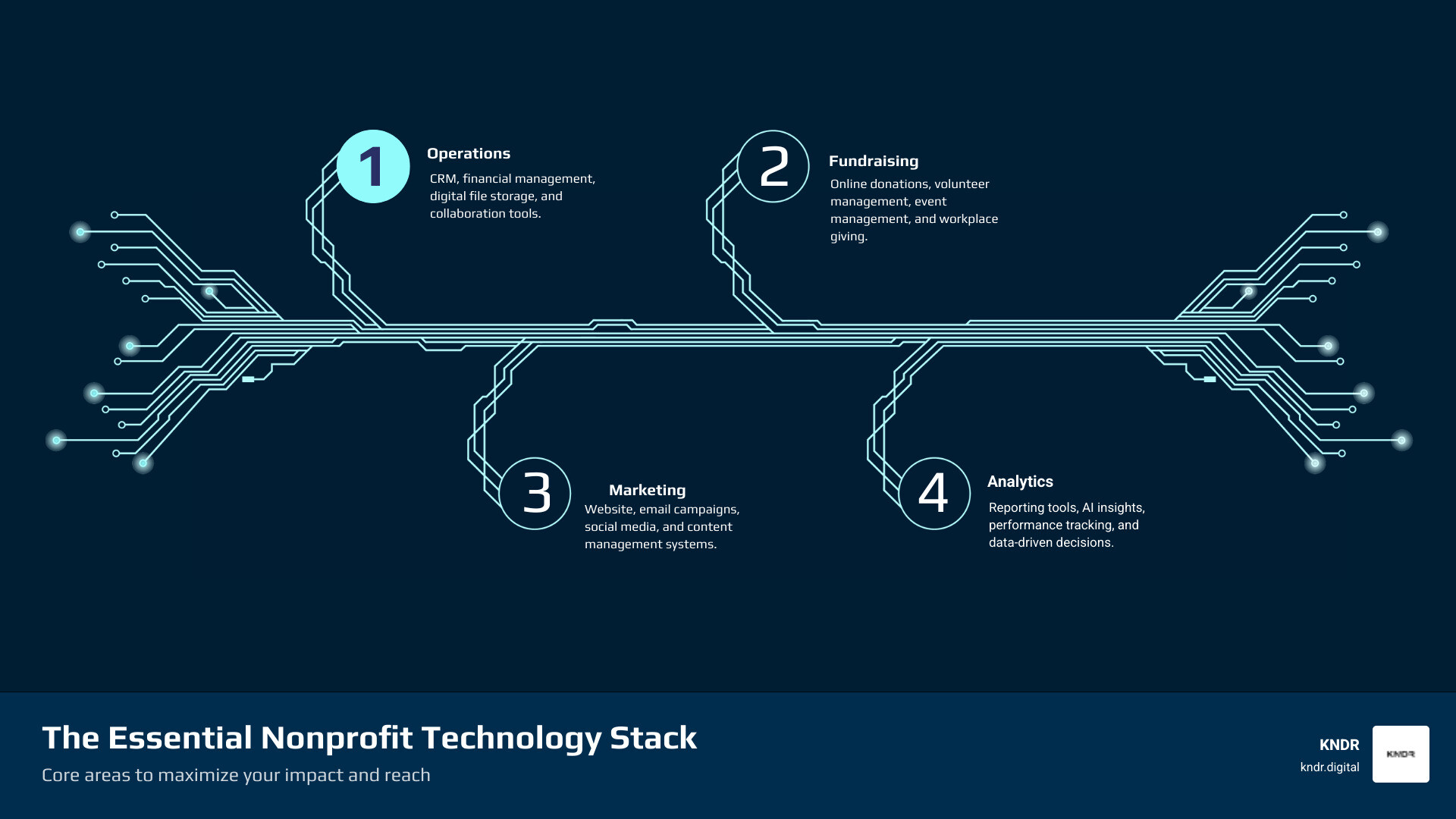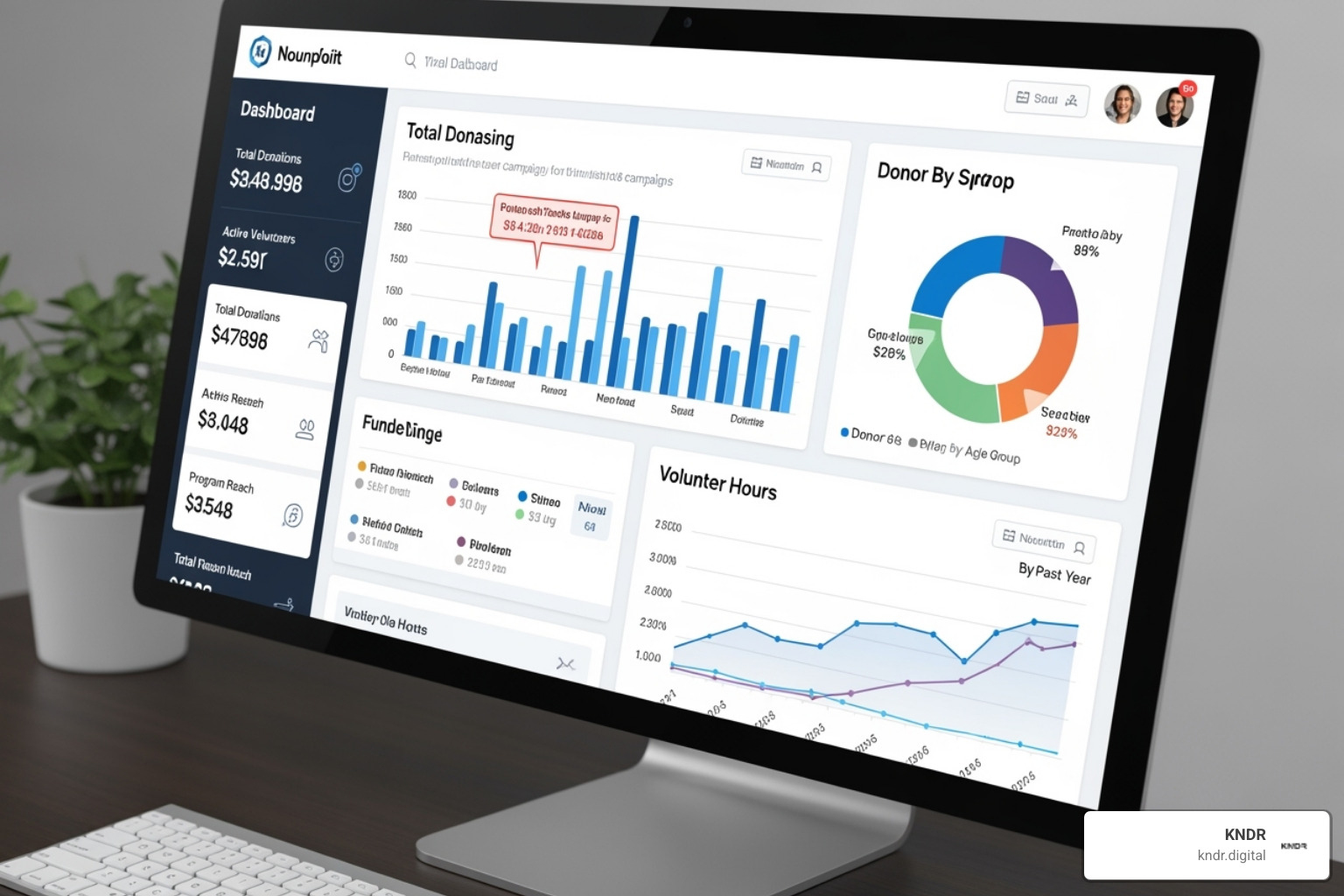Powering Your Mission: The Must-Have Technologies for Nonprofits

Why Technology for Nonprofits is More Critical Than Ever
Technology for nonprofits is essential for organizations wanting to maximize their impact. Here are the core tech areas every nonprofit needs:
Essential Nonprofit Technology Categories:
- CRM Systems - Track donors, volunteers, and relationships
- Fundraising Software - Online donations, peer-to-peer campaigns
- Communication Tools - Email marketing, website, social media
- Financial Management - Accounting, reporting, compliance
- Analytics & Reporting - Measure impact, track performance
- Volunteer Management - Scheduling, engagement, coordination
- AI & Automation - Streamline tasks, personalize outreach
The pandemic accelerated the need for digital strategies. As one nonprofit consultant noted, organizations that don't prioritize modern technologies are leaving impact on the table. When your team has the right tech, they spend less time on routine tasks and more on mission-critical work.
The challenge is choosing the right tech stack without breaking your budget or overwhelming your team. The key is to identify tools that address your specific needs, whether it's boosting donations, managing volunteers, or proving your value to donors. The right tech can transform your operations.
I'm Mahir Iskender, founder and CEO of KNDR.digital, where I help nonprofits leverage AI-powered marketing and fundraising systems to scale their impact. Through my work with hundreds of mission-driven organizations, I've seen how the right technology for nonprofits can turn struggling campaigns into thriving movements that attract new supporters and drive real change.

Know your technology for nonprofits terms:
The Foundation: Core Operational Technologies
Your nonprofit's operational technology for nonprofits—CRM, financial tools, and collaboration platforms—is the foundation of your mission. Without it, everything else is shaky. When operational tech works, your team focuses on impact. When it fails, they get bogged down in administrative tasks.

How a CRM System Drives Nonprofit Success
Your Constituent Relationship Management (CRM) system is the heart of your organization, tracking every interaction, donation, and volunteer hour. It's your single source of truth for all constituent data.
Here's what makes a great CRM transformative:
- Centralized donor data: Ensures everyone on your team has the same information, preventing miscommunication.
- Smart segmentation: Allows you to group supporters by giving patterns or interests for targeted communication.
- Relationship tracking: Captures every interaction, ensuring smooth transitions when staff changes occur.
The best CRM systems offer custom fields, detailed donor profiles, easy reporting, scalability, and integrations with your other tools. A well-implemented CRM transforms Donor Management Software from a simple database into a strategic relationship-building tool.
Streamlining Operations with Financial and Collaboration Tools
Beyond your CRM, your operational backbone includes financial and collaboration tools.
- Digital file storage: Cloud-based systems boost productivity by allowing remote access to files and preserving institutional knowledge during staff transitions.
- Financial management software: Goes beyond bookkeeping to help you track funds, generate reports, ensure compliance, and make data-driven program decisions. This financial clarity helps prove your impact to donors.
- Collaboration tools: Project management platforms, video conferencing, and messaging apps are vital for keeping remote and hybrid teams connected and productive.
When these tools are integrated, your team can focus on amplifying their impact and advancing the mission.
Amplifying Your Voice: Marketing and Communication Tech
Great programs aren't enough; you must tell your story effectively. Technology for nonprofits revolutionizes how you share your mission, connect with new audiences, and convert visitors into advocates. Your website is your digital handshake, emails can nurture donors, and social media shows the human side of your mission.

Why a Strong Website and CMS are Crucial
Your website is your digital front door and often the first point of contact for potential supporters. Getting it right is critical.
- First impressions are crucial. A clean, professional design builds trust, while an outdated site can drive visitors away.
- Mobile responsiveness is non-negotiable. With most users browsing on phones, your site must adapt seamlessly to any screen size.
- Secure and fast hosting is essential to protect donor data and prevent visitor frustration, which can harm search rankings.
A good Content Management System (CMS) is vital. It allows your team to update content, publish blog posts, and share stories without needing a developer. Running a nonprofit blog helps establish your organization as a thought leader. This digital foundation is key to your Digital Marketing for Charities strategy.
Improving Communication and Marketing Efforts
With a solid digital foundation, you can use communication and marketing tech to engage your audience and grow your community.
- Email automation nurtures relationships by sending personalized, automated sequences like welcome series for new donors and reminders for volunteers.
- Social media engagement is more challenging now as organic reach has declined. A strategic approach is necessary, and paid advertising helps overcome this by targeting specific demographics interested in your cause.
- Real-time engagement tools like live chat and interactive polls create immediate connections, allowing supporters to ask questions and feel more involved.
Integrating these tools is key. Your CMS, email, and social media should work together to share content across all channels. Successful Charity Digital Marketing requires a strategic, multi-channel approach to create consistent, engaging experiences.
Want to stay ahead of the curve? Get nonprofit tips and tools to keep your marketing efforts fresh and effective.
Fueling Your Mission: Fundraising and Engagement Technology for Nonprofits
Fundraising is essential for any nonprofit's survival and impact. Fortunately, technology for nonprofits has transformed how we raise money and engage supporters. Digital tools have moved fundraising beyond letters and galas, enabling global reach and automated, personalized thank-yous.

Essential fundraising and donor engagement technology for nonprofits
Digital fundraising is a game-changer. The right software improves donor connections and offers 24/7 accessibility through online donation forms. Modern platforms support multiple giving options, including one-time gifts, recurring monthly donations, peer-to-peer campaigns, and crowdfunding for specific projects.
Crucially, fundraising software should integrate with your CRM. This automatically updates donor profiles, enabling effective and personal Digital Fundraising Strategies. A smooth donor experience increases the likelihood of repeat giving and deepens Nonprofit Donor Engagement.
Streamlining Volunteer and Event Management
Volunteers and events are vital for connecting supporters to your mission. Technology for nonprofits simplifies the management of both.
Volunteer management tools streamline the volunteer journey with simple online portals for browsing opportunities and signing up. Automated scheduling and reminders reduce staff workload, while tracking and celebrating contributions fosters a sense of belonging.
Event management software is essential for in-person, virtual, and hybrid events, handling everything from registration to follow-up. Key features include easy online registration, attendee communication tools, and mobile-friendly options. For fundraising events, look for mobile bidding and text-to-give capabilities. These tools support your Fundraising Campaign Management strategy, ensuring every event is impactful.
Open uping Hidden Revenue with Workplace Giving
A frequently missed opportunity is workplace giving, a $5 billion industry with an estimated $4-7 billion in matching gift funds going unclaimed annually. Programs like matching gifts and volunteer grants can multiply your supporters' impact.
The main challenge is donor awareness. Searchable workplace giving databases integrated into your donation page make it easy for donors to check their eligibility. This knowledge often encourages larger donations.
This is low-effort, high-reward fundraising. An integrated database works automatically to help donors access matching funds, increasing donation values without extra staff time. It's a win-win: donors maximize their impact, companies meet giving goals, and your nonprofit receives more funding.
The Future is Now: Leveraging AI and Data Analytics
The technology for nonprofits landscape has evolved rapidly. What was once science fiction is now a daily reality, with the pandemic accelerating the adoption of smart tech. AI and data analytics are now practical tools that can revolutionize nonprofit operations and fundraising. Organizations using the Best AI Tools for Nonprofits are already seeing significant results.
How Nonprofits Can Leverage AI for Fundraising and Operations
AI's power is its ability to handle complex tasks quickly, freeing up nonprofit staff for mission-critical work. Key applications include:
- AI-powered prospecting: Analyzes data to identify potential major donors, improving fundraising efficiency.
- Personalized donor outreach: Uses AI to understand donor preferences and tailor messages, making supporters feel valued.
- Content generation: AI can draft grant proposals, social media posts, and appeal letters, saving hours and sparking creativity.
- Automation of routine tasks: AI handles repetitive work like updating records, forming the basis of Nonprofit Fundraising Automation.
- Predictive analytics: Forecasts campaign success and identifies at-risk donors, a core component of AI-Driven Fundraising strategies.
Getting started isn't overwhelming. Resources like Microsoft's program to Empower your nonprofit with AI offer grants and guidance.
Making Data-Driven Decisions with Analytics and Ethical AI
As we adopt AI and analytics, we must use them ethically and make data-based decisions.
Analytics and reporting tools are essential for tracking performance, calculating ROI, and identifying trends. Demonstrating impact with data builds donor trust and informs Data-Driven Fundraising.
With this power comes the responsibility of ethical AI implementation. This includes prioritizing donor privacy, ensuring data security, and actively working on bias mitigation. Transparency about data usage and AI's role builds trust. Human oversight is also essential, as AI should augment, not replace, human judgment and empathy.
Resources like Google's Responsible AI for nonprofits offer guidance on navigating these ethical considerations.
Strategic Tech Adoption: Making the Right Choices
Choosing the right technology for nonprofits is a strategic decision that strengthens your mission. It's not about chasing trends but about finding scalable tools that help you serve people more effectively. Rushing into purchases can lead to systems that don't fit your needs or handle growth.

Key considerations for choosing technology for nonprofits
A clear framework is essential when evaluating new technology. Key considerations include:
- Scalability: Will this solution support future growth in donors and programs?
- Mission alignment: Does the tech fit your specific nonprofit needs, not corporate ones?
- Integration capabilities: Your tools must work together seamlessly to save time and reduce errors.
- User experience: The software must be intuitive for your entire team to ensure it gets used.
- Vendor support and training: Choose a partner that offers comprehensive training and responsive support.
- Security and data protection: Ensure any tool meets current security standards to protect donor data.
- Total cost of ownership: Look beyond the subscription price to include implementation, training, and maintenance costs.
You'll often choose between all-in-one platforms (convenient, integrated) and best-of-breed tools (specialized, customizable). The right choice depends on your organization's size, expertise, and needs.
Ensuring ROI and Gaining Buy-In
Convincing your board to invest in tech requires showing how it will amplify your mission's impact. Present a clear cost-benefit analysis, framing the cost against potential gains like identifying new donors or saving administrative hours. Highlight non-financial benefits like reduced staff burnout and an improved donor experience.
When presenting to your board, focus on mission impact, not technical features. Address concerns about implementation and learning curves head-on by presenting a clear plan, such as a phased rollout or extra training.
Professional development is key to adoption. Resources like on-demand nonprofit courses can build the digital literacy needed to maximize your tech investments. Buy-in is an ongoing process; keep your board updated to maintain their support and turn them into advocates.
Frequently Asked Questions about Nonprofit Technology
Navigating technology for nonprofits can be overwhelming. Here are answers to common questions.
What are the most essential technology tools for a small nonprofit just starting out?
For a new, small nonprofit, focus on these budget-friendly and easy-to-manage essentials:
- A solid CRM system: Your top priority for tracking all donor and volunteer data in one place.
- A website with a donation page: Your digital front door. It should tell your story and offer a simple, secure, mobile-friendly way to give.
- Email marketing tools: Essential for keeping supporters engaged with impact updates. Many platforms offer nonprofit discounts.
- Basic accounting software: Necessary for compliance and financial transparency with donors from day one.
These four tools provide a solid foundation you can build on as your nonprofit grows.
How can we afford new technology on a tight budget?
While budgets are tight, the cost of outdated systems can be higher than investing in modern solutions. To afford new tech:
- Seek grants and discounts: Many companies, like Microsoft, offer free technology grants and discounts that can dramatically reduce costs.
- Use a phased implementation: Start with the most critical tool (like a CRM) and add others as your budget allows.
- Consider open-source options: These can be free but often require more technical expertise.
- Focus on high-ROI tools: Invest first in technology that will quickly pay for itself, such as a platform that boosts donations or automation that saves staff time.
- Look for free starter tiers: Many providers offer free basic plans perfect for small organizations.
How do we get our staff and volunteers to adopt new technology?
Resistance to new technology is normal. The key is to frame the change as supportive, not disruptive.
- Involve your team in the selection: When people help choose the tools, they feel a sense of ownership.
- Provide comprehensive training: Offer structured sessions, clear documentation, and a supportive environment. Use external resources like the Digital Skills Center to help.
- Communicate the benefits: Clearly explain how the new tech will make each person's job easier and more effective.
- Appoint internal champions: Empower tech-savvy team members to become an informal support network.
- Offer ongoing support: Create clear channels for help and conduct regular check-ins. Adoption is a process, not a one-time event.
Conclusion: Build Your Tech Stack, Power Your Impact
The right technology for nonprofits makes it possible to achieve more. From CRMs that manage donor relationships to AI that brings precision to fundraising, technology amplifies your mission and reach. Consider if your current systems are holding you back. Are you losing time to manual data entry or losing donors due to inefficient processes? A strategic approach to technology offers solutions.
Strategic investment isn't just buying software; it's choosing scalable, mission-aligned, and integrated tools that support your work now and in the future. Future-proofing your mission means creating an adaptable tech foundation that makes growth feel natural, whether you're scaling donor numbers or launching new programs.
Empower your team with tools that reduce frustration. Easy volunteer sign-ups, instant data access, and clear reporting make everyone more effective, allowing them to focus on impact, not outdated processes.
At KNDR, we see how AI-driven systems transform fundraising. Our results-focused approach delivers more donations, deeper engagement, and sustainable growth. We're so confident that we guarantee 800+ donations in 45 days or no payment. This reflects our belief in what's possible with the right tech foundation.
The path forward is simple: start with the essentials, prioritize integration, and keep your mission at the center of every decision. The best technology is the kind your team uses to better serve your community.
Ready to accelerate your mission with the right technology? Check out our services.


